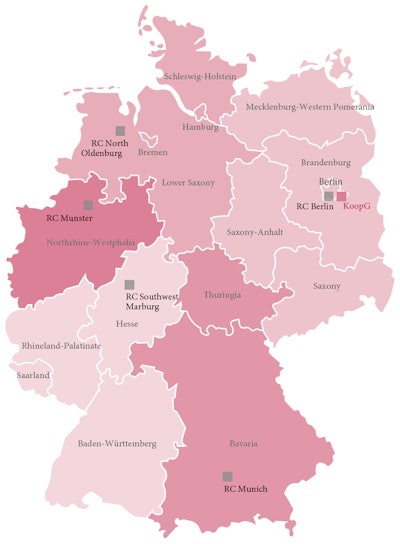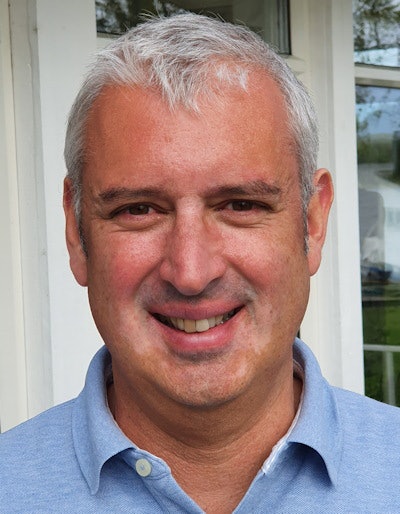
The reluctance of women to take up breast cancer screening invitations remains a serious issue for organizers of programs in Germany and Sweden, as they seek to clear the backlog of examinations and implement new procedures. Uptake of screening is as low as 30% in some regions, and maintaining patient throughput is proving difficult too, they say.
Cancer screening services are still suspended in some of those countries hit hardest by the COVID-19 pandemic, such as the U.K. Elsewhere in Europe, breast screening has resumed successfully, although considerable modifications are being made.
The picture in Germany
In Germany, all women between 50 and 69 (over 11 million) are invited biannually for breast cancer screening under the national screening program organized in 95 screening units. But from mid-March 2020, some screening sites at hospitals were closed due to reallocation of resources to emergency cases, according to Dr. Vanessa Kääb-Sanyal, program manager of the Kooperationsgemeinschaft Mammographie in Berlin.
Some screening units experienced a decline in participation rates, down to 30% of the usual rate, while in other areas, screening continued as usual. Screening invitations were officially stopped between 25 March and 30 April, meaning no screening examinations were performed during April.
 Map shows location of Kooperationsgemeinschaft Mammographie (KoopG) and the five reference centers (RC) with their assigned region of responsibility. Image courtesy of Dr. Vanessa Kääb-Sanyal.
Map shows location of Kooperationsgemeinschaft Mammographie (KoopG) and the five reference centers (RC) with their assigned region of responsibility. Image courtesy of Dr. Vanessa Kääb-Sanyal.All screening units resumed service in May. On average, between 100,000 and 120,000 women are screened each month, but in some units, screening is currently provided with reduced capacities because of issues such as restricted room availability and lack of staff. Throughput is about six women per hour (and mammography system), with a range of four to eight women, she told AuntMinnieEurope.com.
The backlog of patients waiting for mammography varies between units, but it is thought to be about 150,000 to 200,000 examinations in Germany. Some units were only closed for about three to four weeks, while others were shut down for two months and had to resume screening service with reduced capacity.
"Depending on the available resources, screening units are increasing their capacity by prolonging opening hours, using additional screening sites, increasing screening days, and raising throughput to clear the backlog," Kääb-Sanyal noted. "Screening units will try to clear the backlog this year. Nevertheless, due to restrictions in available resources, there will be big differences between each unit's ability to process the backlog."
Women who missed appointments or had them suspended are invited back first, and in general, the strategy is to avoid very long individual screening rounds and instead prolong the round for many women by a short amount of time.
 Dr. Vanessa Kääb-Sanyal
Dr. Vanessa Kääb-Sanyal"To ensure the procedure is safe for patients and staff, a number of anti-contamination processes have been put into place. Protective personal equipment (PPE), masks, and disinfectant are made available for staff and women, and wearing a mask in the unit is mandatory," she commented. "Staff familiarize women about the procedure beforehand so communication can be avoided while in close contact during the actual examination."
Units have introduced a number of other infection-control measures, such as the installation of plexiglass windows at counters. More gaps have been added between seats in waiting areas, and posters specifying hygiene measures within the unit are displayed.
"Anxiety and uncertainty of staff and women pose a big challenge to continue (or resume) screening services, so in addition to appropriate actions to minimize risk of infection, clear information and communication should be provided in invitation letters and brochures," she noted. "Clear and honest information should be provided to radiologists from officials or central management."
Suspension of screening services for a short period (one to two months) was reasonable to allow time for obtaining PPE, preparing the screening sites, reorganizing the screening procedure, and providing accurate information to women, she said. Suspended exams have now been systematically rescheduled and a safe screening service provided.
Swedish experience
In Sweden, all counties have resumed screening, but some are doing so at reduced capacity to maintain patient safety, according to Dr. Joakim Ramos, chairman of the national working group on mammography in Sweden.
"We screen 40- to 74-year-olds every 18-24 months, but many counties have temporarily excluded the 70-74 age group for reasons of safety. Most counties, but not all, have a prolonged interval," he told AuntMinnieEurope.com.
Since a change in the law in 2016, the interval between screening visits cannot be longer than 24 months, but because of the pause in screening due to COVID-19, about 75% of Swedish counties report a longer interval at present, particularly in the 70-74 age group, which have been excluded by more than half of the counties temporarily, he explained. Some counties did not pause or reduce screening, but they are seeing lower attendance than normal. A second invitation to screening is sent to a patient who misses her first appointment, so this will give these counties a higher number of patients to call for a second chance.
"This all together gives a longer interval, and the screening sites will have problems to catch up. The patients who come to screening today should have been here in March," he explained. "We cancelled the early invitations when we paused screening. Usually we send the invitation letter four weeks in advance."
 Dr. Joakim Ramos.
Dr. Joakim Ramos.The recommendations regarding personal safety equipment differ from center to center, added Ramos, who is a member of the board for imaging in Västmanland County in central Sweden. Many sites have introduced screening sessions in the evenings and during weekends to reduce the number of patients gathered in the waiting area at the same time.
"Each county gives its own recommendations to hospitals, but we must comply with national general recommendations (not specific to healthcare) not to have more than 50 people in the same event, including at the same screening venue. The general recommendations are more like common sense guidelines to keep your distance, etc. Our National Health board has not told us to close units or open them again," he said.
"Due to strict hygiene rules on disinfection between every patient, there is very little extra to be done in the examination room. In the patients' waiting room, we have upgraded the disinfection standards, but that does not take time from the actual examination," Ramos continued. "Very little can be done to improve workflow; we only have about five minutes per patient in the examination room. It's hard to improve on that."
Before the pandemic, the attendance rate in most counties was between 80% and 85%, or even higher, but during June, the rate has varied considerably and is between 43% and 85%. "This is strange. The average is under 80 now anyhow, clearly less than normal," he reported.
Changes at the Karolinska
 Dr. Fredrik Strand, PhD.
Dr. Fredrik Strand, PhD.Breast screening restarted on 1 June at the world-famous Karolinska Institute in Stockholm. The facility has developed its own safety guidelines for the protection of staff and patients. Extra space has been created in the waiting room, and entry to the waiting room is strictly controlled, with no patients admitted until 10 minutes before the examination time.
"We're inviting women in groups of 200, instead of 400 as usual, and not inviting the over 70s," commented Dr. Fredrik Strand, PhD. "Of those invited, about 50% accepted in the first week, but this figure has now risen to 68%, compared to 71% overall last year."
It only takes a few minutes more to disinfect the machine between patients, he said.
"Other centers have restarted screening, and some did not stop. It has been a regional decision about when to stop and start," Strand stated. "The national situation is starting to normalize."
Screening resumes in Hungary
All of Hungary's 50 or so screening centers restarted their work on 1 June, with the limit of four patients per hour, and the same happened with diagnostic exams, according to Budapest radiologist Dr. Gábor Forrai, PhD, past president of the European Society of Breast Imaging (EUSOBI).
"From 15 June, the four-patient limit was canceled, so everything has now returned to normal, but with many precautions being taken to guard against cross-infection," he said, adding that EUSOBI plans to issue new recommendations soon about how to resume work in breast centers and to prioritize patients.
Guidance from the U.K.
Overall, a plan to restart services will depend on the size and location of the screening service and make and age of equipment, and it must consider the safety of staff and clients, equipment, and the stresses on workloads of the screening and physics services, as well as service companies, stated recent guidance from the U.K. Society of Radiographers (SoR).
"The close proximity we have to be in when performing mammograms goes against the advice of keeping your distance from each other; we are directly in the path of the women's breath," noted the SoR.
The society recommends the following:
- Make your employer aware of the staff concerns because they are responsible for the health and safety of their employees.
- Perform a local risk assessment taking advice from your infection control team, which may include removing vulnerable staff from the service or preventing women from attending.
- Review the risk assessment daily, taking into account the latest government guidance, employer restrictions, and staff concerns.
- Find out how x-ray equipment should be stored when not used for months and what action is required before restarting screening.



















